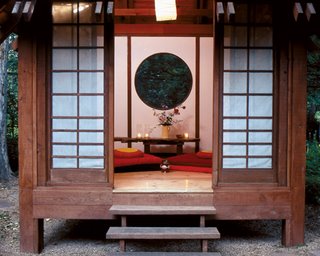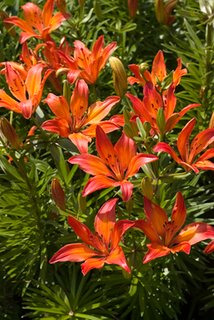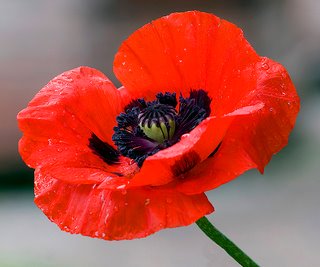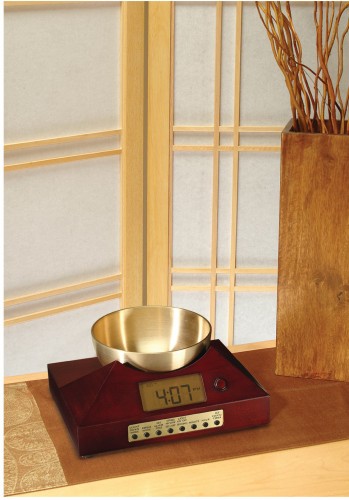Kyoto meets Giverny in this artful garden, a sublime space for contemplation.

teahouse, photo by Povy Kendal Atchison
Japanese shoji screens traditionally are made from translucent rice paper, but the owners chose a durable, light-penetrating fabric that will prevail in harsh weather. It allows filtered light without sacrificing privacy. The floor is salvaged pine planks from a park ranger’s mountain cabin, and a round window brings in the garden even when the doors are closed.
Ten years ago, a Boulder, Colorado, couple bought a house on a patch of grass with some overgrown shrubs, sliced by an irrigation ditch. Where many people might have seen desolation, these intrepid gardeners saw the opportunity to create a private world of solitude and renewal. In the process, they discovered that designing and planting is as soothing as enjoying the completed garden.
The contemplative garden they’ve created gently nods to Asian style while embracing European impressionism. It borrows from 19th-century impressionist painter Claude Monet, as well as from the Japanese love of plant textures, weeping trees and artfully placed rocks. It includes water, rocks, expanses of greenery and winding paths, but not the formal Japanese plantings that require so much upkeep.
Monet’s famous garden in Giverny, France, includes a Japanese bridge over a water lily pond. In this Colorado garden, a pale-aqua bridge arches over an irrigation ditch that’s been funneling water to farmers for 100 years. Just as the lily pad pond became the Monet garden’s major draw, the ditch has been transformed—lined with sandstone rocks alongside a bed of river rocks. Gold, yellow and orange daylilies drape the bank, blooming in midsummer when the Siberian and Japanese irises offer only seed pods. Ornamental grasses bend and sway to the breeze stirred up by the water’s flow. The ditch is an enticement; visitors brace against the railing and peer into the water, watching blossoms float downstream.
Every corner of this garden was designed with careful thought, not lavish funds. A decade of hard work and trial-and-error provided an education.
Piecing together elegance
Every corner of this garden was designed with careful thought, not lavish funds. A decade of hard work and trial-and-error provided an education. In hindsight, the homeowners believe their decision to tackle their garden in small pieces rather than taking on the entire half-acre saved them time, money and frustration.
“We didn’t have a grand master plan,” one of the homeowners admits. Instead, he started by clearing dead and dying trees. Then he parceled the property into smaller gardens: a ditch lined with water-loving plants and flagstones circles the edges of the gardens and is sprinkled with elfin thyme and other herbs for groundcover.
To imitate nature’s undulating, uneven landscape, he built mounds, or berms, from garden soil, adding interest to the flat piece of land. Berms also provide quick drainage for plants that might never take hold without humus and gravel. Sun-loving plants such as foxtail lilies and peonies are located on the sunny mounds. Shade-loving hostas line the flagstone walkways under giant locust trees.
“It all came together like a jigsaw puzzle,” the gardener says, with groundcovers of thyme and vinca, creeping veronica, wild strawberries and sweet woodruff. Groundcovers that can become invasive thugs, such as the sweet woodruff, were banished to the riverbank under the house, where it can duke it out with ornamental strawberries for space and light.
What’s in this garden?
• Crabapple trees (Malus spp), highly adaptable to most weather and soil conditions, have exquisite spring blooms. The weeping varieties include Red Jade, Coral Cascade, White Cascade and Louisa. Best to order from your local garden center.
• Species (or wild) tulips (Tulipa spp) have brilliant hues and hardiness. Long before more formal tulips became the backbone of Dutch gardens, miniature species tulips blanketed hillsides in Turkey. Most only can be grown in climates with winter temperatures. Order from trustworthy companies (see “Resources,” below) that propagate their own bulbs and do not harvest from the wild.
• Foxtail lilies (Eremurus spp) have attention-grabbing feathery spikes and day-glow colors. They’re easy to grow, but they do require good drainage to avoid root rot.
• Thyme (Thymus spp) may be slow to start, but once established, it tolerates some foot traffic. Best as filler between stepping stones, aromatic thymes will creep around rocks and steps, choking out weeds.
• Daylilies (Hemerocallis spp) have sweeping, grasslike foliage and arching blooms. Each blossom lasts only one day, but the plant blooms nonstop throughout summer. They require little care aside from division every few years, and only a moderate amount of water.

daylilies
• Irises (Iris spp) are easy to grow if you choose the right cultivars for your garden. Siberian and Japanese irises grow best in moist, slightly acid soil, perhaps on the banks of a pond or stream. For alkaline soil and aridity, choose bearded irises. And if you love variegated leaves of white and green, look into Iris pallida.
• Hostas (Funkia spp), with wide, variegated leaves, add to foliage interest rather than floral displays. Lords of the shade garden, hostas can be found in a variety of sizes, some with blue-tinged or gold coloration and heart-shape leaves. All need some moisture and dappled shade.
Four seasons of splendor
In this garden, bold plants such as peonies and foxtail lilies are the prima donnas—showy and extravagant with heavy blooms. Other beauties are far smaller and require a closer look. Brilliant red and yellow species tulips—more natural looking than their formal, hybrid cousins—pop up among drifts of thyme. Delphiniums and their smaller brethren, larkspur, join foxgloves for height and extravagant color. Oriental poppies and California poppies display papery petals, popping up in mounds and drifts.

oriental poppy
In early spring, the bright blues and purples of the groundcovers cluster throughout the garden, complementing the species tulips’ tiny blooms. By late spring, foxgloves and Siberian and Japanese irises dominate. Summer is golden, as daylilies offer orange, yellow and cream colors.
The garden may be at its best in winter, the gardeners claim. Japanese lanterns guide visitors down the flagstone footpath, and snow sets a black-and-white scene. Bare, weeping crabapple branches bend gracefully like sculpture. “Some of the most beautiful times in the garden are in the snow,” the homeowner says. “You see all the shapes that don’t go away: the mounds, rocks, ornaments, trellises.”
Reflecting in the teahouse
Autumn and winter usher in the garden’s quiet moments, when trowels are put away. A tiny teahouse, built of salvaged cedar siding left over after the house was built, holds sway. Once inside, a cup of hot tea banishes the cold. Sliding shoji screen doors open to the sparkling light on snow or close to keep out a brisk wind. The nine-by-nine-foot teahouse anchors this garden, a reminder that its primary purpose is to promote meditation and reflection rather than busyness. A Zen Timepiece adornes the interior so that one can timer their meditation practice. The naked branches of an old cottonwood tree loom over the teahouse while smaller pines and dwarf evergreens screen the street and neighborhood. “The teahouse gave us a focus for the garden,” the homeowner says, “and cut down the amount of lawn.”
In winter’s stillness, when birds are silent, only the bamboo wind chimes clink softly. The teahouse’s back wall features a round window that provides the most private views and connects the garden to the teahouse. “I wanted a big round window,” the owner says, “to bring the outside in.”

Zen Timepiece with brass singing bowl, a meditation timer.
adapted from Natural Home Magazine, March/April 2008 by Niki Hayden
Now & Zen
1638 Pearl Street
Boulder, CO 80302
(800) 779-6383
Posted in Bamboo Chime Clocks, Chime Alarm Clocks, Japanese Inspired Zen Clocks, Now & Zen Alarm Clocks, teahouse, Well-being, Zen Timepiece by Now & Zen, Zen Timers